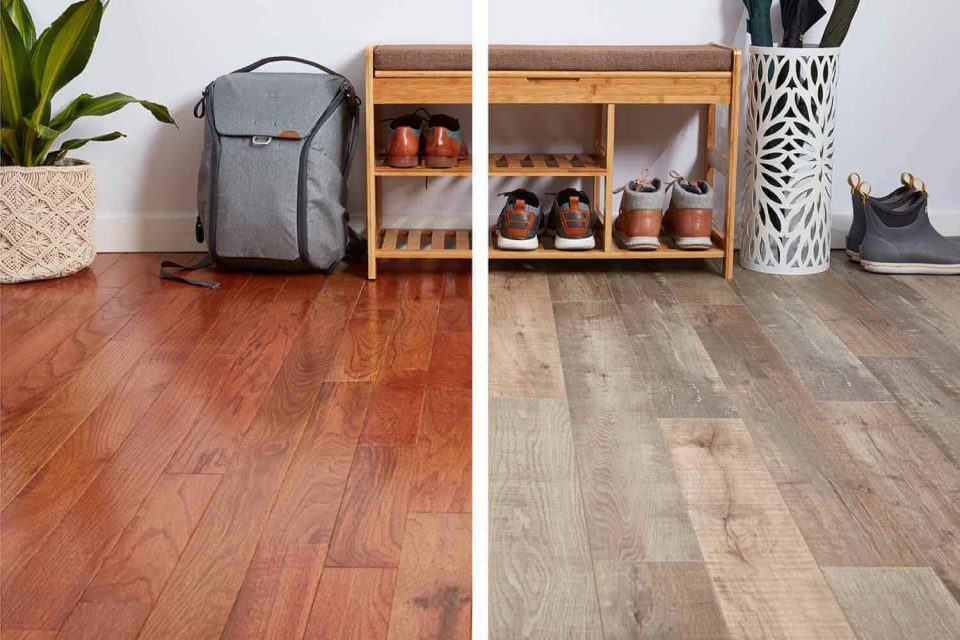Laminate or Solid Hardwood Flooring: Which Should You Choose?
Table of Contents
When it comes to choosing the perfect flooring for your home or office, deciding between laminate and solid hardwood flooring can be tough. Both offer unique benefits and drawbacks, and it is important to consider various factors before making a final decision.
In this comprehensive guide, we delve into the key differences between laminate and solid hardwood flooring, helping you make an informed choice that suits your needs and preferences.
How to Decide Between Laminate and Solid Hardwood Flooring
Choosing the right flooring for your home requires a considerable amount of research. If you are torn between laminate and hardwood, this guide will help you make a decision.
But first, let’s understand what laminate flooring is.
Understanding Laminate Flooring
Laminate flooring is a popular choice for homeowners due to its affordability, durability, and versatility. It is composed of multiple layers, with a high-density fiberboard (HDF) or medium-density fiberboard (MDF) core, a photographic layer that mimics the appearance of real wood, and a protective wear layer. This layered construction provides exceptional resistance to scratches, stains, and moisture, making it suitable for high-traffic areas such as living rooms, kitchens, and hallways.
One of the major advantages of laminate flooring is its wide range of design options. Manufacturers can replicate the look of various hardwood species, stones, tiles, or even unique patterns, giving you the freedom to achieve your desired aesthetic. Additionally, laminate flooring is relatively easy to install thanks to its click-and-lock or glueless installation systems. Both save you time and money on professional installation.
Now, let’s understand solid hardwood flooring.
Exploring Solid Hardwood Flooring
Solid hardwood flooring is a timeless classic that exudes elegance and natural beauty. Crafted from a single piece of solid wood, these planks offer unparalleled authenticity and charm. Each plank boasts a unique grain pattern, colour variations, and natural imperfections, which contribute to its warm and inviting appeal. Solid hardwood is available in a wide array of wood species, such as oak, maple, cherry, and walnut, each with its own distinctive characteristics.
One significant advantage of solid hardwood flooring is its longevity. With proper care and maintenance, solid hardwood can last for generations, making it an excellent long-term investment. Furthermore, solid hardwood is known for its ability to be sanded and refinished multiple times, allowing you to restore its original beauty and extend its lifespan.
Now that we have explored the characteristics of both laminate and solid hardwood flooring, let’s compare them based on various factors to help you make an informed decision:
-
Durability and Maintenance
Laminate flooring is highly durable and resistant to scratches, stains, and fading. Its protective wear layer acts as a shield against everyday wear & tear, making it suitable for busy households with children and pets. Cleaning laminate flooring is relatively easy, requiring regular sweeping and occasional damp mopping. However, it is important to note that laminate is susceptible to moisture damage, and excessive water exposure should be avoided.
Solid hardwood flooring, while durable, is more susceptible to scratches and dents than laminate. However, its natural wear adds character and charm to the floor. Proper maintenance involves regular sweeping or vacuuming to remove dirt and debris, as well as occasional refinishing to address scratches and restore the floor’s lustre.
-
Aesthetic Appeal
Laminate flooring offers a wide range of design options, allowing you to achieve the look of various hardwood species, stones, or tiles. The photographic layer on top of the laminate plank convincingly replicates the texture, colour, and grain pattern of real wood, providing a budget-friendly alternative to solid hardwood. However, laminate may lack the authentic feel and depth of real wood.
Solid hardwood flooring boasts a natural beauty and elegance that cannot be replicated. The genuine grain patterns, colour variations, and unique characteristics of each plank create a warm and inviting ambience in any space. Solid hardwood adds a touch of luxury and sophistication that can significantly enhance the overall aesthetic appeal of your home or office.
-
Installation and Cost
Laminate flooring is known for its easy installation, thanks to its click-and-lock or glueless installation systems. This allows for a quick and hassle-free installation process, making it a suitable option for those with basic DIY skills. In terms of cost, laminate flooring is generally more budget-friendly than solid hardwood, making it an attractive choice for those seeking an affordable flooring solution.
Solid hardwood flooring requires professional installation, as it often involves nailing or stapling each individual plank to a subfloor. This installation can be time-consuming and requires specialized tools and expertise. Additionally, solid hardwood tends to have a higher upfront cost. However, considering its longevity and a potential increase in property value, solid hardwood can be a worthwhile investment in the long run.
-
Making the Decision
Choosing between laminate and solid hardwood flooring ultimately depends on your needs, budget, and aesthetic preferences. If you prioritize affordability, durability, and a wide range of design options, laminate flooring may be the ideal choice for you.
On the other hand, if you value authenticity, longevity, and the timeless beauty of real wood, solid hardwood flooring may be the perfect fit. It is highly recommended to consider your budget and lifestyle when making your choice.
Both laminate and solid hardwood flooring have their merits and considerations. By carefully evaluating the factors discussed in this guide, you can confidently select the flooring option that best aligns with your requirements and vision for your space. Visit your nearest home improvement store to find your best choice.

